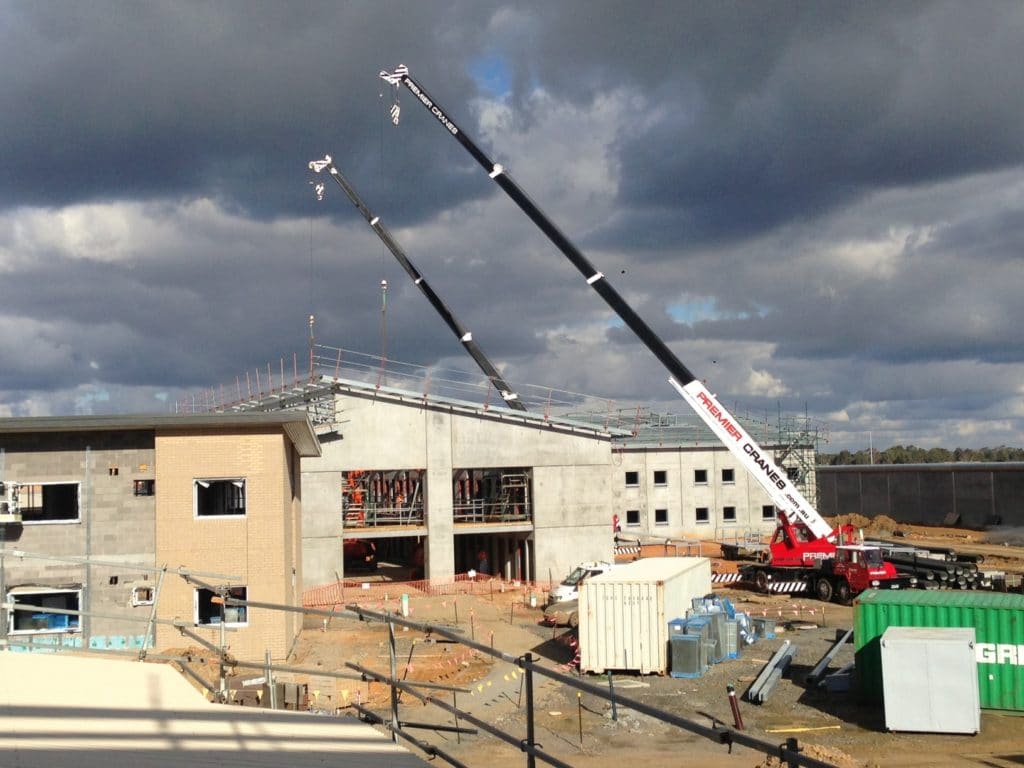Using Mobile Cranes in Dangerous Weather

Operating mobile cranes in inclement weather conditions can not only risk potential damage to your equipment, but also injuries to anyone working. This is why at Premier Cranes & Rigging, our operators are trained to monitor changing weather patterns and to know when it’s time to delay lifting arrangements to ensure safety for everyone on site.
When it comes to operating a mobile crane in poor or extreme weather conditions we stick by the rule that if we’re not sure, we never risk it.
Below is our advice on how the most dangerous weather condition of them all; lightning storms, can affect planned lifts and what to do to control and reduce any risks associated with this type of unpredictable weather.
Mobile Crane Operations During Lightning Storms
A lightning storm is one of the most dangerous weather conditions to be operating a crane in. This is due to steel being highly conductive of electricity, meaning any strike to the crane can not only damage or cause malfunction to the electrical systems, but also be lethal if an operator is inside the cabin.Unlike tower cranes which may have lightning rods installed to provide protection, mobile cranes and similar lifting equipment typically don’t. This means the risk of operating this equipment during lightning storms is higher and should almost never be undertaken.
Minimising the Risk of Lightning Strikes to Cranes
There is both precautionary and on the day actions that can be taken to minimise the risk of lightning strikes to mobile cranes. While in an ideal world precautionary measures would be sufficient, this is not always possible as weather can change rapidly on the day of a lifting job.
Precautionary measures to prevent Cranes getting caught in Lightning Storms
Our team checks the forecast in the area of crane operation to reduce the risk of getting caught out by inclement weather conditions. We need to protect our workers and partners primarily, the wider community, and then our mobile cranes and equipment.
Fortunately, lightning is more often associated with weather conditions that prohibit mobile crane use like heavy rain and high wind, which means many lightning strikes to lifting equipment occur when they are unmanned.
The danger is rapidly approaching storms with dense clouds that build up before the lightning, wind and/or rain arrive. These types of conditions can sometimes be missed by meteorology bureaus and other weather forecasting services or reported on when the crane operator is already on site.

What to do if there is a Storm Warning or unexpected weather conditions on the day of your Mobile Crane Hire?
According to the CICA – Vic / Tas Branch Crane Safety Bulletin, shutting down a construction site and derigging cranes for every storm ‘warning’ could be unviable. Particularly in subtropical or thunderstorm prone climates. To remain safe while efficient in storm-prone areas, two things are highly recommended of any mobile crane crew:
- An accurate lightning detection method
- A clear plan of what to do as the information is received.
There is always the rule of thumb that the time in seconds between the lightning and thunder multiplied by 340 is the distance to the storm. However, if you’ve seen lightning or heard thunder you’re already in danger! Even if you are able to only just hear distant thunder, you are still at risk of being struck by lightning, so work should have already stopped.
Remember, as rare as lightning strikes are, it’s not a chance you want to take.
Why Hire Premier Cranes for Unpredictable Weather?
Regardless of the job, our team of motivated and passionate crane and rigging professionals thrive on challenges. We have selected and trained our workers to be skilled riggers and operators who, as experts in their field, are able to resolve issues on the ground quickly and collaboratively.
At Premier Cranes & Rigging, we are able to seek alternative solutions to reduce installation timeframes and provide cost savings to our customers, in case of extreme weather conditions. These attributes provide a point of difference in a competitive industry. Our performance has enabled us to establish a strong reputation and build strong long-term business partnerships.